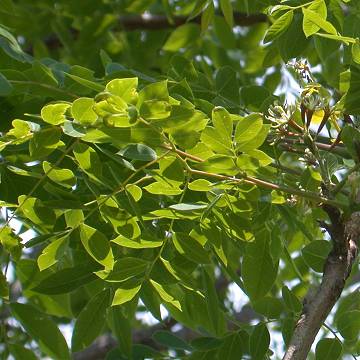

Gymnocladus dioica - (image 1 of 9)
Taxonomy
Family: Fabaceae
Habitat
Along streams, often on floodplains. Also in mesic forest.
Associates
Woody associates include Acer saccharinum, Aesculus glabra, Asimina triloba, Celtis occidentalis, Cercis canadensis, Fraxinus americana, Juglans cinerea, Ulmus americana.
Distribution
Most of the eastern half of the US. Absent from LA, FL, NH, VT and RI. Endangered in NY.
Morphology
Medium deciduous tree with a narrow crown. Leaves alternate, bipinnately compound, with about 70 leaflets on 2-7 pairs of branches, to 36" long and 24" wide; leaflets elliptic-ovate, entire, acute, to 3" long, rounded or cuneate at the base, bluish-green, on short petiolules. Flowers whitish, petals 4-5, sepals 4-5, in large terminal panicles, appearing in spring with the leaves, fragrant, insect pollinated. Dioecious. Pods up to 8" long with a hard husk, dark red-brown, leathery, with a dusky appearance, remaining on the tree through the winter. Bark gray, hard, with thin scaly ridges curling outward along their edges.
Notes
Flowers late May or June when the leaves emerge
Wetland indicator: Upland
Leaves emerge late and fall early, leaving the trees bare for more than half of the year. Hardy to zone 4 and occasionally planted as an ornamental. Said to be tolerant of urban conditions and a range of soils.
The seeds were thought to have been used at one time as a coffee substitute, although they are known to contain the toxic alkaloid cytisine. Dirr writes that "in my youth I ate the sweetish gummy substance that lines the inside of the pod. Maybe that's what is wrong with me today."
There have been some recent name changes to the legume family. I have decided to adopt the family name Fabaceae for this species. Gymnocladus belongs to the subfamily Caesalpinioideae, as do the genera Cercis and Gletidsia.
References
Dirr, Michael A. 1998. Manual of Woody Landscape Plants:
Their Identification, Ornamental Characteristics, Culture, Propagation and Uses.
5th ed. Champaign, Illinois: Stipes Publishing L.L.C.
Farrar, J. L. 1995. Trees of the Northern United States and Canada.
Ames, Iowa: Iowa State University Press
Swink, F. and G. Wilhelm. 1994. Plants of the Chicago Region.
Indiana Academy of Science. The Morton Arboretum. Lisle, Illinois.
|
Michael Hough © 2005 |